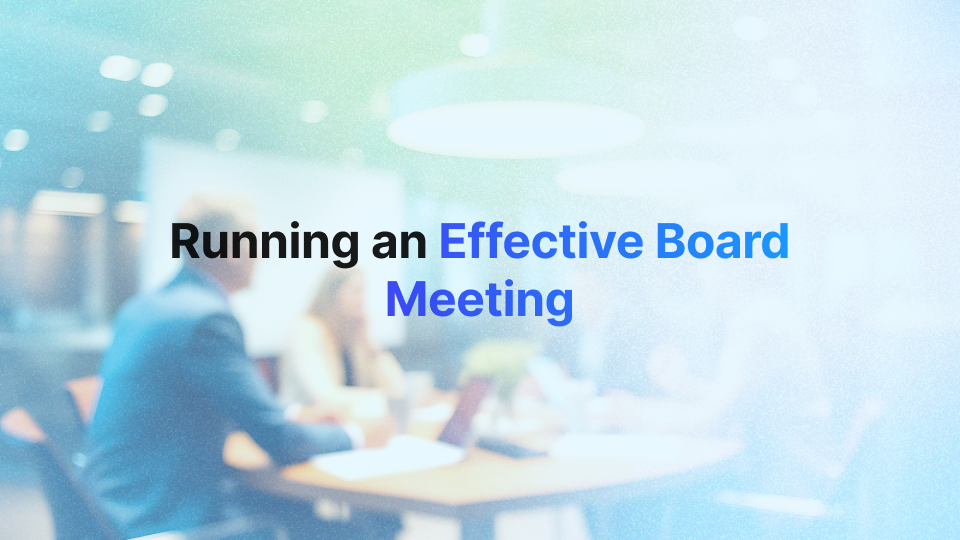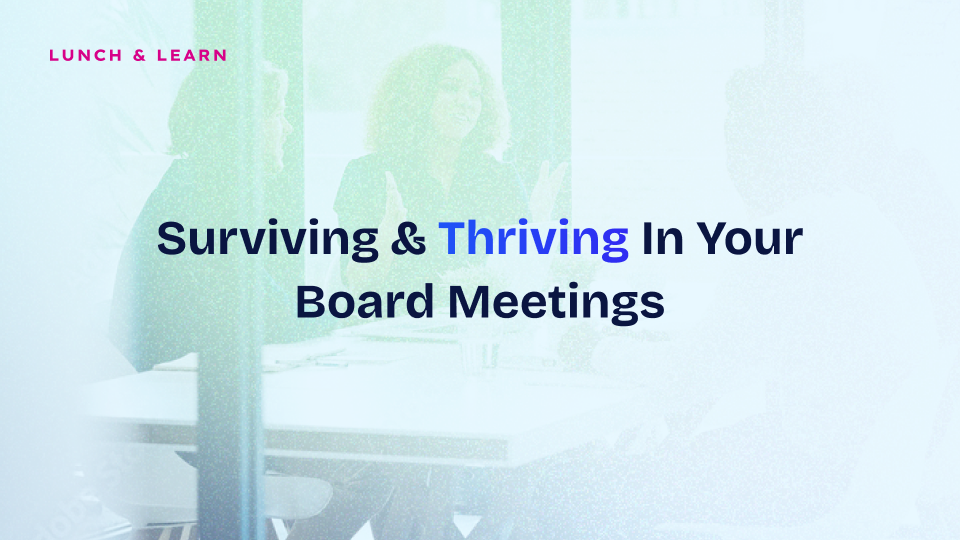- All
- Structure & Composition
- Meetings & Requirements
For founders, establishing a board can initially feel like relinquishing control. The early stages demand your full attention on product development, customer acquisition, and revenue generation. However, as your startup matures, the need for a board emerges – whether for fundraising or operational support. Beyond governance, a board offers a valuable opportunity to pause, reflect, and benefit from diverse perspectives.
Knowing when to embrace this transition and leverage it to your advantage is pivotal for growth and success.
Startup Evolution: Understand how the need for a board evolves as your software startup progresses. Typically, in the first year or two, founders are focused on product-market fit, building product, finding customers, and generating revenue. A board's necessity usually emerges after this initial stage.
Timing is Key: Some founders try to avoid setting up a board, or are unsure when the right time is. You need to recognize the signs and make an informed decision.
CEO's Role: The CEO's role is critical. They must be proactive in setting up the board and selecting the right people.
Say “board of directors” to an early-stage founder and the gut reaction is often:
Accountability. Oversight. Loss of control.
But here’s the truth:
A board isn’t a burden. It’s a structure. One that can actually help you win—if you build it right.
When you raise your first institutional round, yes—you’ll be asked to form a board.
That’s normal. That’s expected. But it’s not out of your hands.
You have more control than you think.
You decide:
→ Which investors get a board seat vs. an observer seat
→ Whether a co-founder joins you on the board
→ Who you bring in as your independent board member
This early board formation matters—a lot. These are the people who will help shape the next chapter of your company.
Done right, your board becomes:
• A source of high-leverage advice
• A forcing function for clarity and focus
• A strategic sounding board with skin in the game
So don’t just accept the default. Talk to other founders. Ask how their investors show up. Think hard about the dynamic you’re creating.
Your board should be a growth engine—not a governance tax.
Feeling like your board is a burden? That might be a sign that it's time to take a closer look at how you, as the CEO, are managing that relationship.
I've heard the complaints, and maybe you've said them too:
👉 “The board made me do this.”
👉 “They don’t understand my business, so I’m not going to listen.”
👉 “The board made that decision, and I didn’t agree.”
It's easy to fall into the trap of blaming the board. But here’s the truth: if your board isn't functioning well, that’s a CEO responsibility, not a board failure.
Have you run into a situation where different board member priorities don't align with the founders? Or different investor board members are not in-sync when it comes to exit size and timing?
Different Investor Priorities: Be aware that seed, expansion, and growth stage investors have different priorities. You need to understand each investor's fund horizon, liquidity priorities, and available follow-up investment dollars.
1. Where are you in the lifecycle of the fund you used to invest in us?
2. Is it a new fund, or are you actively looking to exit?
3. Where do we rank among your other portfolio companies?
4. Are you actively looking to invest more in our company?
5. What is your personal priority? Are you looking to stay on the board much longer?
As startup founders, early on, your focus is on building the product, finding customers, and validating your value proposition. And that’s exactly where it should be. But as your startups grows, the need for a board—and potentially a board observer—starts to take shape. Maybe it’s tied to raising capital or needing structure to help scale.
Here’s the thing about board observers: They might not have voting rights, but they’ll often have just as much to say as a full board member. They won’t hold back, nor should they. That’s why choosing a board observer is just as critical as choosing a full board director. Observers can bring valuable insight, challenge your thinking, and help guide your company.
The purpose of a board of directors is to have a set of experienced, value-adding board members who can help you figure out how to build your company. And for them to do that, they need to deeply understand your business and its health and prospects. It is your job to give them that knowledge.
If preparing board packs feels like a huge effort, there are underlying issues that need to be addressed. Ideally, what you share with your board should be the same information you share with your executive team and employees. This includes:
• The health of the business (KPIs)
• Achievement against planned targets
• Detailed and accurate financial information
• Sales pipeline coverage and forecasts
• Any other analytics used to run the business day-to-day (product deliverables against timeline, customer churn analysis, etc.)
You should have all this information readily available because this is what you should be using to run your business day to day. At this point, you should not be running the business with your gut feel like you did when you first started.
🔥 First-time CEO? Don’t let your board meeting run you.
Let’s be real—if you’re scrambling to put the board deck together, you’re not running the company the right way.
Too many first-time CEOs treat board meetings like a performance review. But the board doesn’t want a show—they want a real view into the business, and more importantly, a chance to help.
Here’s how to take control:
📆 Start 3–4 weeks out.
Draft an agenda early. Pressure-test it with your lead investor or board chair so you’re focused on what really matters.
📤 Send your materials early.
Last-minute decks lead to surface-level conversations. Give your board time to prepare—so they can actually contribute.
📊 Build the deck from what you already use to run the business.
If you're reinventing slides for the board, ask yourself why those metrics aren’t already being tracked internally.
⏩ Make the meeting 80% about the future, 20% about the past.
Remember: the board meeting isn’t about recapping the past—it’s about shaping the future. Spend 80% of your time on what’s ahead: bets, risks, decisions.
💡 “The goal is not to impress your board. It’s to get their help.”
🔥 That first board meeting? It’s not just a milestone — it’s a mindset shift.
For most early-stage founders, it comes with a mix of anxiety and resistance:
❑ “Do I really need a board?”
❑ “Is this going to slow me down?”
❑ “Am I giving up control?”
We see this all the time at Companyon Ventures. We invest at the moment when companies are just starting to operationalize — right when someone says, “Hey, it’s time to put together a board.”
Here’s what I tell founders: you have more control than you think.
A well-structured board becomes your sounding board, not your shadow.
One of our founders, Hersh Tapadia (CEO of Allstacks), nailed it. He didn’t wait for his Series A to figure out how to run board meetings. He built structure, crafted a narrative, and tested it early — even when that meant inviting tough feedback from early investors and advisors.
Consistency. Storytelling. Transparency.
That’s what turns board meetings from time-sinks into strategic assets.
If you’re raising soon, now’s the time to take control of your board — not after the term sheet is signed.
🚀 Fundraising founders — want to run board meetings that actually adds value?
Here’s a tip from operators and investors who’ve seen a lot of boardrooms:
🔥 Stop cramming all your updates into the board meeting
Seriously—if your board is seeing KPIs, pipeline, or cash position for the first time in the meeting, you’ve already lost the plot.
The operating metrics you share with your board should come straight from the same dashboards and updates you use to run your business day to day.
If preparing for a board meeting feels like a heavy lift, that’s a sign.
Either:
❑ You're not tracking and sharing enough with your own team
❑ You're pulling together info that’s not actually useful
Use off-cycle updates. Monthly emails. Live dashboards. Quick summaries.
That’s how you keep your board aligned in real time — and free up the meeting for real discussion.
When it is time for the board meeting, treat it like a performance:
→ Send the deck a few days early (not the night before)
→ Call your board members — make sure they’ve read it and surfaced questions in advance
→ Preview the agenda with 1–2 folks the week before to sharpen it
→ Book recurring 1:1s with each board member — even 15 mins a month helps
And if board members aren’t coming prepared or adding value?
Call it out. This is your company. Your board works for you.
The best founders build this muscle before their Series A.
They use board meetings as a leadership tool — not just a reporting obligation.
There are three types of founding CEOs, and the difference between them isn’t just experience—it’s mindset.
➊ The Wise CEO – They’ve been through the startup grind before. They know what they don’t know and surround themselves with experienced operators, advisors, and a board that actively helps them execute their vision.
➋ The Coachable CEO – They may not have prior startup experience, but they recognize their own gaps. They listen, adapt quickly, and aren’t afraid to course-correct. This humility is a sign of true confidence—not weakness.
➌ The Lone Wolf CEO – They refuse to admit what they don’t know, fearing it’ll make them look weak. They resist hiring people who challenge them and avoid tough conversations with their board. Investors and board members see this as a major red flag.
The strongest founders aren’t the ones who have all the answers—they’re the ones who build a team (and a board) that helps them find the right ones.
An unfortunately common challenge with startups: A founding CEO who is not delivering. I’ve seen this scenario play out more than once. It doesn’t happen overnight—it creeps in gradually until it becomes a full-blown crisis.
Let's be clear first. Early-stage founders are everything to a startup—vision, passion, execution. But as the company scales, the game changes. It’s no longer about sheer hustle; it’s about leadership, delegation, and execution at a higher level.
The best founders evolve. The worst? They stay in denial.
🛑 The single most damaging thing a founder can do is refuse to acknowledge there’s a problem.
The best thing? Own it. Ask for help.
A practical gut-check: Revisit your last fundraising deck and your last set of board meeting presentations. Look at the promises you made to your board and investors—growth targets, execution milestones, key hires. Now, compare those projections to reality. Are you where you said you’d be?
🔥 Rosy Forecasts & Missed Numbers: What Your Board Is Really Thinking
👉 You set an ambitious revenue target.
👉 You miss it.
👉 Now you’re in front of your board, trying to explain why.
Here’s the truth: The original revenue forecast? It probably started as a fundraising narrative but quietly morphed into your operating plan. And now it’s the number the board, your team, and maybe even you are holding yourself to.
So let’s be clear:
👉 Missing a forecast isn’t the problem.
👉 Failing to manage expectations—and not owning the miss—is.
👉 Founding CEOs who get this wrong lose credibility fast.
Here’s what great CEOs do:
✅ They remind the board (and themselves) that startup plans are assumptions, not guarantees.
✅ They flag risk early and often.
✅ They shift the focus from blame to root cause—Why did we miss? What are we doing about it?
Are you building a culture that learns or performs for the pitch deck?
That’s not a board problem.
It’s a business problem.
Early-stage founders: stop thinking of your board as a control mechanism. Start thinking of it as a strategy squad you handpicked.
Ask yourself:
→ Who do I want in the room helping me see around corners?
→ Who can challenge me without creating drag?
→ Who brings real execution wisdom — not just opinions?
That’s your board.
And when you frame it that way, it’s not something to fear—it’s something to leverage.
Treat your board like a quarterly ops huddle — not a compliance review.
Use it to pressure-test decisions, confront hard tradeoffs, and stay laser-focused on what actually moves the needle.
Board seat math matters more than you think
When you set up your board, follow one simple rule:
- Not 3. Too fragile.
- Not 7. Too bloated.
- Five is the sweet spot.
The mix that works:
• 2 common shareholder seats (CEO + co-founder or CFO)
• 1–2 investor seats
• 1–2 independent seats
Avoid setups where investors outnumber the founding team. And never skip the independent—good ones bring balance, clarity, and the hard truths neither side fully sees.
Yes, having a co-founder in the second common seat is convenient, and sometimes the co-founder is the right persona. But I've also seen co-founders add zero (and sometimes negative) value. When that happens, remove the co-founder and bring in a CFO or another independent.
Your board isn’t just oversight. It’s an ops braintrust. As CEO, it’s on you to shape it so it challenges, guides, and helps you scale—rather than just nodding along.
👉 How have you structured your board to get the most value out of it?
Founders, don’t sleep on the independent board seat.
It’s not just a checkbox. It’s your leverage.
The right independent balances investor interests with founder perspective and brings operational wisdom you won’t always get from your cap table.
Here’s what to prioritize:
• Early-stage CEO experience
• Deep industry understanding
• Empathy for what it’s actually like to build from scratch
This is your chance to add someone who’s been through the fire. Someone who can mentor you, challenge you, and help you grow into the CEO your company will need next.
And here’s the truth:
Board leadership starts with confidence.
Not control, but command—of the structure, the relationships, and the process.
Great boards don’t just happen. Founders build them.
Next Video Coming Soon...

-1.png?width=960&height=540&name=Assembling%20Your%20Board%20and%20Preparing%20(Thumb)-1.png)







.png?width=1920&height=85&name=Group%2045056%20(1).png)

I'm Co-Founder and General Partner at Companyon Ventures, an early-stage VC firm focused on B2B software and AI startups. I started my career as a co-founder, launching three software startups during the first wave of the internet. Two didn’t make it, and the third made it. Those years were full of hard lessons—about product-market fit, go-to-market execution, hiring mistakes, and the sheer grit it takes to build something from the ground up. That experience gave me a deep empathy for founders and a firsthand understanding of what it really takes to scale a software startup.
After my time as an operator, I transitioned into venture capital — first at Insight Partners, then as a founding partner at OpenView Venture Partners. At both firms, I focused on helping SaaS companies grow with capital efficiency and operational discipline. That mix of operator scars and investor pattern recognition has shaped how I work with founders today: not just as a capital partner, but as someone who’s been in the trenches and knows how to help them navigate what’s next.



.png?width=961&height=541&name=Group%2045064%20(1).png)
